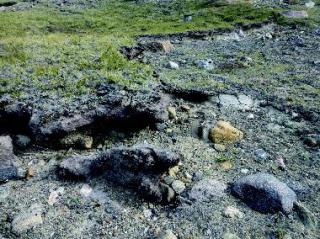Aug 14 2015
Strong winds blowing off the Greenland Ice Sheet are eroding soil and vegetation in the surrounding tundra, making it less productive for caribou and other grazing animals, carbon storage and nutrient cycling, a Dartmouth College study finds.
 Ruth Heindel, a Ph.D. student in Dartmouth's Department of Earth Sciences, and her colleagues found that winds blowing off the Greenland Ice Sheet are eroding soil and vegetation in the surrounding tundra. (Credit: Ruth Heindel)
Ruth Heindel, a Ph.D. student in Dartmouth's Department of Earth Sciences, and her colleagues found that winds blowing off the Greenland Ice Sheet are eroding soil and vegetation in the surrounding tundra. (Credit: Ruth Heindel)
Arctic soils are a critical but fragile ecological resource threatened by wildfire, permafrost degradation and other climate-related disturbances that are well studied. But wind-driven soil erosion has not been well documented, especially in western Greenland where it poses the greatest threat to soil stability.
The findings appear in the journal Annals of the Association of American Geographers. A PDF is available on request.
"Understanding the current distribution of wind-eroded patches is a first step toward a more complete picture of regional wind erosion and its ecological impacts, especially as the Arctic continues to experience rapid environmental change and warming temperatures," says lead author Ruth Heindel, a Ph.D. student in Dartmouth's Department of Earth Sciences and a fellow in the IGERT Polar Environmental Change program.
The researchers used satellite imagery and remote sensing techniques to analyze wind erosion in the Kangerlussuaq region of western Greenland, where bare ground patches around the ice sheet are much less productive than the surrounding landscape. The region's soils have developed on a layer of loess, or loose sediment that is easily eroded by the wind.
The researchers wanted to know if soil erosion is controlled by proximity to the ice sheet or by the lay of the land, including the direction and steepness of nearby hillsides. In addition, they considered whether bare patches near the ice sheet are similar in size, distribution and denudation as those farther away since wind patterns, vegetation and climate all vary with distance from the ice sheet. Winds blowing off the ice sheet tend to be drier and colder than those coming off the fjord.
Results showed that bare patches covered 22 percent of the land in the study area, ranging in size from about 100 square feet to more than 1,000 square feet. The bare patches were more widespread near the ice sheet but restricted to steep south-facing slopes farther away from the ice sheet. This pattern suggests that strong downslope winds blowing off the ice sheet are responsible for the soil erosion. In addition, the eroded patches close to the ice sheet contain less vegetation than those farther away.
The vegetation around the eroded areas is a mixture of shrubs and grasses, but grasses dominate within the eroded patches. Across the Arctic, shrub species are expanding into grass habitat, but the new findings show how wind erosion may limit the spread of shrubs by providing better habitat for grasses or an environment dominated by lichens, mosses, cyanobacteria and microfungi.
The findings are a snapshot of current soil erosion in western Greenland rather than an analysis of changes over time, which the researchers are currently conducting. The Greenland Ice Sheet has experienced record melting in recent years, but it is relatively stable in western Greenland. If the ice sheet retreats in this region, soil erosion is expected to be more restricted to steep south-facing slopes, but the already bare patches could remain denuded for a long time.